American bomb against enemy bunker
One of the first such ammunition was the English bombs "Tollboy" and "Grand Slam" during the Second World War. Due to the large mass and shape of these bombs in the fall accelerated to record speeds and literally stuck into the ground by several tens of meters. The explosion in the ground for underground structures was much more dangerous than the surface. The most famous victims of the British anti-bunker, or seismic, bombs according to the classification of that time are German submarine bunkers, a railway tunnel near the city of Saumur (France), as well as the multi-gun V-3. After the end of the Second World War, a T-12 bomb of the 20000 caliber kilogram was created based on British ideas in the USA. However, the development of nuclear weapons soon stopped the development of especially powerful non-nuclear bombs designed to destroy underground objects. As it turned out, only for a while.
The return to the bunker ideas came in the early sixties. Achievements of military construction at that time again began to require special ammunition for the elimination of enemy fortifications. However, until some time, all these bombs were made more for the presence, but not for real operations. The wrongness of this approach became clear at the end of 80's. Then the impending Gulf War was already in the air, and the intelligence of NATO countries unequivocally reported a large number of bunkers at the disposal of the Iraqi command. In addition, intelligence said that the existing anti-bunker BLU-109 is unlikely to be able to cope with the destruction of a large proportion of Iraqi fortifications. BLU-109 was not an independent ammunition and could be mounted on the "chassis" in the form of various guided missiles and bombs. This warhead contained about a kilogram of explosive 240, and a cast steel body with wall thickness per inch allowed a BLU-109 rocket to punch up to a meter of reinforced concrete.
The military builders of Iraq responded to such a “sword” with a simple and effective “shield”: the underground structures near Baghdad and other cities were many branched corridors, at the intersection of which there were large multi-storey buildings. All of them lay at a depth of at least 15 meters, and in the thinnest places the thickness of the concrete floors was at least 60-70 centimeters. Obviously, no American guided weapons with a BLU-109 module could cope with such a structure. The first strikes against the objects of Hussein confirmed this.
For this reason, in October 1990, the engineers of ASD (Eglin airbase) were assigned to create an anti-bunker bomb that could cope with Iraqi fortifications. The deadlines were the toughest — the bomb was supposed to be sent for testing next spring. To break through a thick layer of soil and the reinforced concrete following it, the bomb must be sufficiently heavy and durable, otherwise it will collapse before it reaches the very fortification. In addition, for less resistance to air, earth and concrete, the bomb should have a small cross section. Finally, deadlines were running out. The most convenient solution to all problems at once would be to use the available components and materials. Yes, just pick up suitable were, at least, not easy. Someone from the team of Eglinsky engineers offered to pay attention to the barrels of artillery shells. In all respects, parts from M203A2 or M2 201-mm howitzers fit best. Moreover, the barrels of these guns fit not only in size but also in material. By a happy coincidence, M2A2 and M201 were made from exactly the same alloy as the nose of the BLU-109 module. The aforementioned howitzers were actively written off at that time, so the ASD designers did not have a shortage of raw materials. However, on the basis of Eglin there were no appropriate machines to process solid metal trunks. Therefore, pruning, grinding and other technological operations were entrusted to the Watervlit arsenal, where, strictly speaking, the disposal of old tools was made. In addition to cutting along the length of the arsenal, workers had to drill through the channels of the former barrels - for compatibility with the nose of the BLU-109 combat unit, they had to have a diameter of 10 inches (254 mm).
At this "adventure" Eglinskih engineers are not over. As it turned out, the airbase had all the necessary equipment for testing and using bombs, but not for assembling them almost from scratch. Therefore, all the necessary things had to be done by accessible methods. Thus, a special insulator was welded onto the inner surface of the body of future bombs with the help of a makeshift electric heater. Equipment of the first tritonal bombs was also produced by a similar “hooligan” method: nineteen-foot (5,8 meters) hulls were fixed in an upright position and literally began to pour molten explosive into buckets. Finally, the ready-made combat unit, called the BLU-113, was fitted with a GBU-24 bomb guidance system. The entire assembled bomb received the name GBU-28.
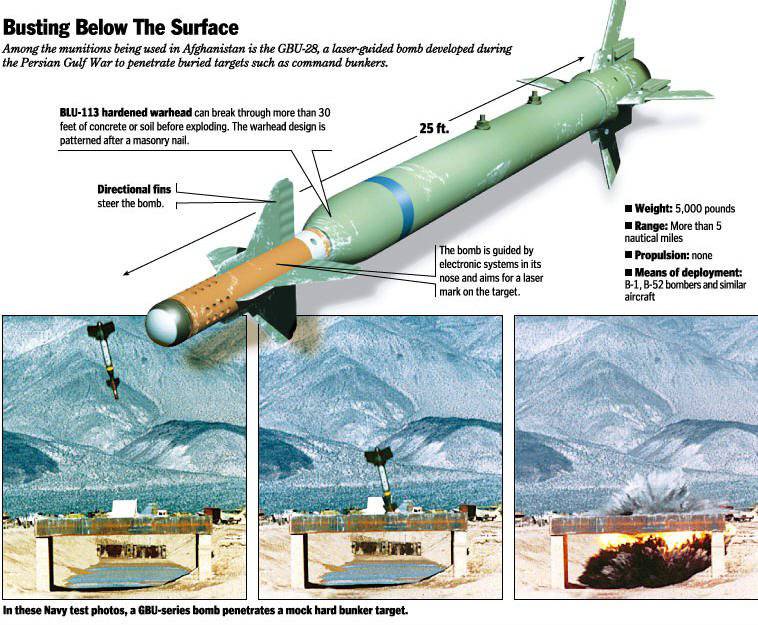
Work on the basis of Eglin ended up testing a new bomb. True, instead of the 30 training exercises put in place, only one was produced. February 24 prototype bomb, dropped from an F-111 bomber, entered the ground three dozen meters away. They measured the depth, recorded it in a report, but did not dig the bomb - they were under pressure and there was no way to do it. The second bomb with the help of a special trolley on the rails was dispersed to the speed at which it should enter the ground, and launched in the direction of concrete slabs. The bomb broke through the entire 22-foot (6,7 meter) plate package, after which several tens of meters flew by inertia. It became clear that the project was a success. Therefore, the military demanded not to conduct further tests at the site, but to test new bombs on real targets.
On the night of February 28 91, under cover of darkness, two F-111 bombers with GBU-28 bombs on a suspension came up to the Baghdad area. The work of the aircraft was organized as follows: the search for the target takes place together, then one of the bombers begins to illuminate it with a laser, and the second one goes into bombing. After hitting the bomb, the planes change places and the attack is carried out first. The first bomb dropped deflected from the target - the targeting unit worked incorrectly. But the second hit exactly the highlighted point and went underground with a characteristic sound. After the dust had settled at the site of the fall, nothing said anything about the attack that occurred, except that there was a hole left for the bomb. But a few seconds after the bomb fell, thick smoke began to flow from the disguised bunker ventilation device. The interpretation of the last event was unequivocal: the bomb broke through the concrete overlap, exploded and destroyed the bunker, which caught fire and, apparently, eventually burned to the ground. Despite only 50% of successful hits, the first combat use of the GBU-28 bombs was considered successful and they were soon put into service. Only four months passed from the mission to the first combat bombing.
The end of the Iraq war of the beginning of the nineties did not have a drop on the creation of new anti-bunker ammunition. So, during the fighting in Yugoslavia, the United States in a combat situation experienced a new combat unit BLU-116. This module was installed on the bombs of the GBU-24 family. The dimensions of the new module corresponded to the BLU-109, with the difference that it had a slightly smaller diameter, and the difference was compensated by a light aluminum casing. The body of the BLU-116 unit itself was made of a special steel alloy with nickel and cobalt additives. Due to this, not only the penetrability of concrete floors remained at the level of previous modules, but also the opportunity to break through several concrete barriers. In combination with the new HTSF fuse, this allows the charge to be exploded on any of the floors of the high-rise bunker: the smart fuse analyzes the alternation of floors and voids.
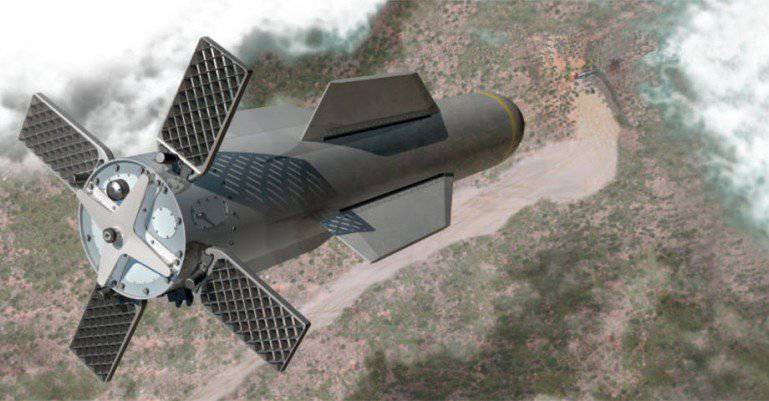
In 2007, it was announced that a new anti-bunker bomb would be launched under the symbol GBU-57. Also, this munition is known under the name MOP (Massive Ordnance Penetrator - Massive penetrating ammunition). The length of the new bomb is approximately equal to the lengths of older ammunition of a similar purpose. But the diameter has become several times larger. Along with him grew caliber. The GBU-57 weighs 30 thousand pounds (about 14 tons), which is several times heavier than any previous US anti-bunker bomb. The overall dimensions of the GBU-57 gently hint at the fact that it is intended for transportation on strategic bombers - B-52 or B-2. In addition, a lot of weight and the corresponding accelerating unit allows the bomb, according to official information from the developers, to break through to 60 (!) Meters of reinforced concrete. 2400 kilograms of explosive will only increase the destruction caused by the bomb. However, not only the characteristics are interesting in this bomb. The fact is that last year the Pentagon ordered two dozen GBU-57 and their first party already went to the troops. It is clear that any adopted weapon must be available in warehouses. But this doesn’t affect the presence of the most logical question: whose bunkers will be the target?
In addition to anti-bunker bombs with tritonal in the United States developed and developed ammunition for a similar purpose, but equipped with low-power nuclear warhead. Only for understandable reasons, such a weapon is unlikely to be used in any operation “to support democracy”. Already very specific attitude of the international community to nuclear weapons. Yes, and all the potential "enemies of democracy" are unlikely to have such underground objects, for the destruction of which a nuclear anti-bunker is absolutely necessary. That, however, also does not remove the question of goals for the GBU-57 and its smaller "brothers".
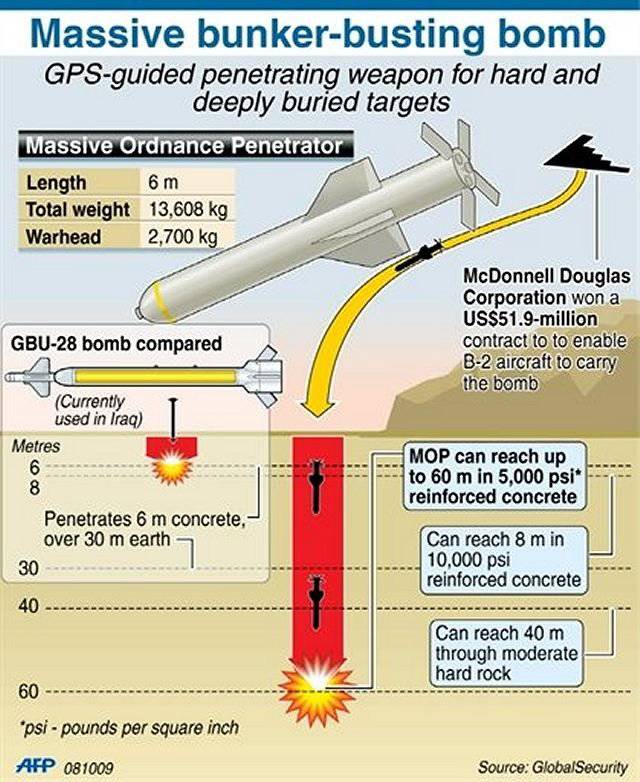
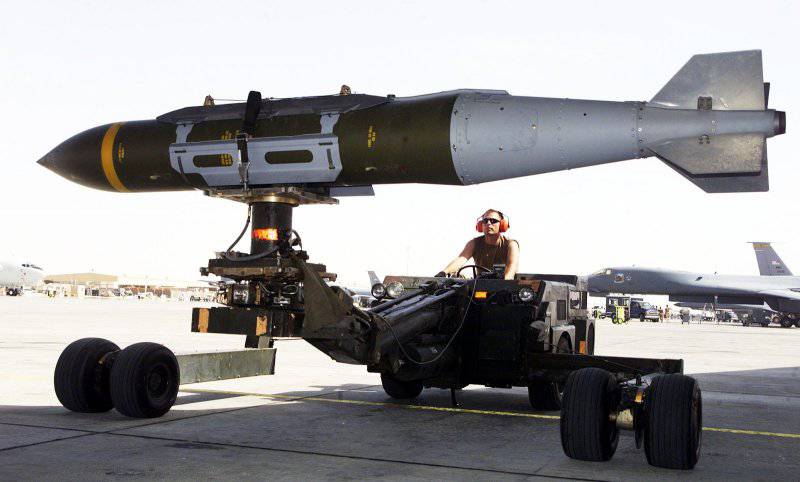
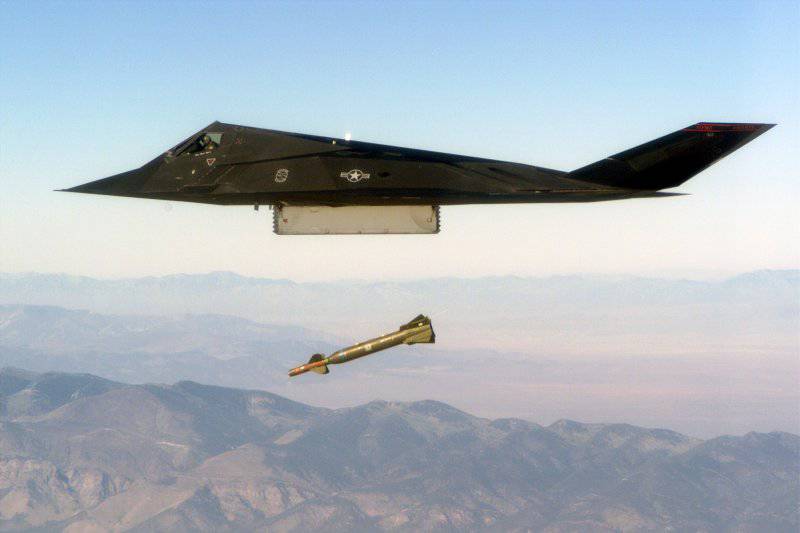
Information